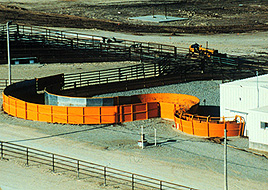 |
Permission is granted to reproduce information on www.grandin.com for educational purposes.
 |
Permission is granted to reproduce information on www.grandin.com for educational purposes.
This section of Grandin.Com contains drawings of cattle corral designs with curved races. Curved cattle chutes are more efficient for handling cattle because they take advantage of the natural behavior of cattle. Cattle move through curved races more easily because they have a natural tendency to go back to where they came from. In the computer aided drawing section there are layout drawings of cattle yard designs for both large and small ranches and feedlots. There are also drawings of a cattle loading ramp for trucks, diagonal stockyard pens for cattle, and detail drawings of a single file race and cattle dip vat. If you are planning to build new corrals or other cattle handling facilites you can download blueprints of cattle pen layouts that will reduce stress on cattle and improve handling efficiency.
Grandin, T.(Editor) 2019 (5th Edition). Livestock Handling and Transport, 3rd Edition. CAB International Wallingford Oxon, United Kingdom.
Grandin, T. (1989, with 2018 updates). Behaviour Principles of Livestock Handling. The Professional Animal Scientist. 5:1-11.
Grandin, T. 2017. On-farm conditions that compromise animal welfare that can be monitored at the slaughter plant. Meat Science. 132:52-58.
Grandin, T. 2017. Temple Grandin's Guide to Working with Farm Animals. Storey Publishing, North Adams, MA, USA.
Grandin, T. 2016. Evaluation of the welfare of cattle housed in outdoor feedlots. Veterinary and Animal Science. 1-2:23-28.
Grandin, T and Shivley, C. 2015. How do farm animals react and perceive stressful situations such as handling restraint and transport. Animals. 5(4), 1233-1251.
Grandin, T. and Deesing, M. 2008. Humane Livestock Handling. Storey Publishing, North Adams, MA, USA.
Grandin, T. (1991). Principles of Abattoir Design To Improve Animal Welfare. In: J.Matthews (Editor) Progress in Agriculture Physics and Engineering. CAB International Wallingford, Oxon, United Kingdom.
Grandin, T. (1990). Design Of Loading Facilities and Loading Pens. Applied Animal Behaviour Science 28:187.
Lima, M.L.P., Paro de paz, C.C., Negrao, J.A., and Grandin, T. 2018. Minor corral changes and adoption of good handling practices can improve the behavior and reduce cortisol release in Nelore Cows. Tropical Animal Health and Production. pp. 1-6.
Kline, H.C., Edwards, L.N., and Grandin, T. 2019. Short communication: Field observations: Pen stocking capacities for overnight lairage of finished steers and heifers in a commercial slaughter facility. Applied Animal Science. 35:130-133.
 Click here to return to the Homepage for more information on animal behavior, welfare, and care.
Click here to return to the Homepage for more information on animal behavior, welfare, and care.